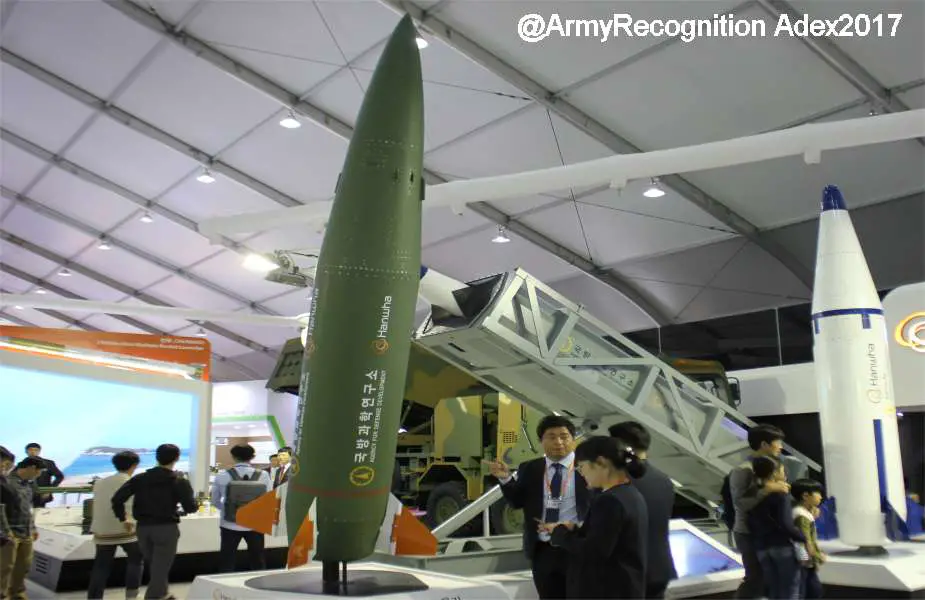South Korea deploys advanced KTSSM-I surface-to-surface bunker-buster tactical missiles
On March 19, 2024, the South Korean Ministry of Defense announced the deployment of its indigenous Korean Tactical Surface-to-Surface Missile-I (KTSSM-I) bunker-buster missiles, capable of neutralizing underground military installations. This announcement comes amid growing concerns over North Korea's advanced armament and its implications for regional security.
Follow Army Recognition on Google News at this link

South Korean Agency for Defense Development Tactical Surface-to-Surface Missile-I (KTSSM-I) (Picture source: Army Recognition)
The Korean Tactical Surface-to-Surface Missile-I (KTSSM-I), known for its ability to penetrate deep into the ground to destroy subterranean targets, is at the forefront of this initiative. This missile system, first unveiled at the ADEX 2017 defense exhibition, is designed to perform precision strikes against North Korean artillery hidden in mountainous terrains and caves, in direct response to the North's shelling of Yeonpyeong Island in 2010, which resulted in the loss of four South Korean lives.
With a range of 180 kilometers and a caliber of 400 millimeters, the KTSSM-I is operational in fixed-land canisters and is known for its heavier warhead. This deployment is part of South Korea's broader strategy to advance its missile technology, including the development of KTSSM-II and KTSSM-III variants, aiming to achieve enhanced capabilities and extended range.
The 2024 Defense Ministry policy report highlights additional measures to strengthen the nation's defense posture against provocations from the North. Among these is the completion of a long-range surface-to-air missile system within the year, aimed at establishing a multi-layered missile defense to protect against missile and artillery threats from the North.
Moreover, South Korea and the United States plan to conduct a joint tabletop exercise simulating a scenario of nuclear use by North Korea. This collaboration will extend to outdoor live drills during the annual Ulchi Freedom Shield exercise in August, underlining the allies' commitment to maintaining peace and stability in the region.
A strategic command dedicated to deterring North Korean threats will also be established, demonstrating South Korea's resolve to address the complexities of nuclear and weapons of mass destruction. This new command, to be led by an Air Force major general, emphasizes the importance of strategic leadership and coordination in defense matters.
In addition to strengthening its defensive capabilities, South Korea's successful launch of an upgraded KTSSM-I variant has sparked international interest, with countries like Saudi Arabia and the United Arab Emirates exploring potential acquisitions. The CTM-290, an export version of the missile, has emerged as a viable competitor in the global arms market, reflecting South Korea's growing influence as a defense technology exporter.
As the CSIS notes, South Korea has adapted its military doctrine to place crucial importance on precision strikes, in response to the growing threat posed by North Korea. At the heart of this strategy, two major operational concepts stand out: "Kill Chain" and "Korea Massive Punishment and Retaliation" (KMPR). "Kill Chain" aims to detect and preemptively neutralize any imminent threat by destroying North Korea's nuclear, missile, and long-range artillery capabilities. This initiative is supported by constant surveillance and intelligence, allowing for a swift response before an attack can be launched. Meanwhile, "KMPR" positions itself as a retaliatory tactic, contemplated in the event of a North Korean nuclear attack or significant conventional offensive, with an additional goal: the decapitation of North Korean political and military leaders to induce regime change.
Alongside these strategies, South Korea is developing the "Korea Air and Missile Defense" (KAMD) architecture to protect its military assets and minimize South Korean civilian casualties. The effectiveness of these measures relies on the intensive use of precision-guided munitions and advanced detection capabilities. Outside the North-South Korean confrontation dynamic, these advanced military capabilities could also serve as an anti-access area denial (A2/AD) framework against possible Chinese aggression. Currently, stable relations between South Korea and a rising China could deteriorate due to various provocations, making these defensive preparations essential to ensure South Korean sovereignty and security against future uncertainties.
- Hits: 3857
















